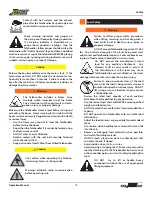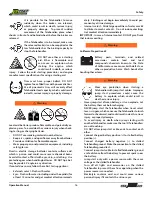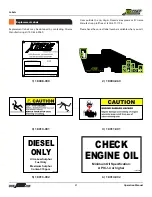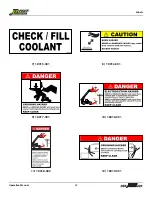
Operation Manual
15
Safety
Attachments
Warning
Improper connection of an auxiliary attachment could
result in death or serious injury. Attachments not locked
into place can become unstable and fall on the operator or
other personnel near the Telehandler.
•
Make sure attachment locking devices are always in
place.
•
DO NOT operate the Telehandler until you have positive
indication that the coupler pin and lever are fully
engaged.
•
Hydraulic attachments have a maximum hydraulic
pressure rating. Failure to make sure the attachment is
equipped with a pressure reducing valve, or is rated to
be equal or greater than 3,500 psi, which is the maximum
pressure of the Telehandler auxiliary hydraulic system
at the quick-disconnect couplers, could result in death
or serious injury.
•
Make sure all hydraulic connections are tight (if
equipped).
Shut Down Procedure
Warning
To prevent death or serious injury, follow these procedures
before leaving the Telehandler cab:
•
Park Telehandler on a firm, level surface.
•
Move travel select lever to NEUTRAL (N).
•
Actuate (engage) the parking brake.
•
Lower forks and attachments to the ground.
NOTE:
The parking brake MUST be actuated (engaged) only
when Telehandler is at standstill.
Always engage the parking
brake before leaving the
Telehandler. The Telehandler can
roll if the parking brake is not ON
(engaged), which could result in
death, serious injury, or property damage.
•
Turn Ignition switch to the OFF position.
•
Remove the key.
•
Unbuckle the seat belt.
•
Place “Do Not Operate” tags on the Starter switch and
steering wheel when maintenance or service is required.
•
Block wheels when maintenance is required.
Telehandler Maintenance
Warning
Follow the manufacturer’s instructions for proper
maintenance to make sure the Telehandler continues to meet
manufacturer’s specifications. Failure to properly maintain
the Telehandler can result in improper performance, which
could cause death, serious injury, or property damage.
Attach “Do Not Operate” tags to the Ignition
switch and steering wheel before beginning
any service or maintenance.
• “Do Not Operate” tags indicate the
Telehandler should not be operated until all
service or maintenance is completed.
•
Keep two (2) legible “Do Not Operate” tags with the
Telehandler at all times. “Do Not Operate” tags are pro-
vided in this manual.
•
DO NOT operate the Telehandler and attachments if
they require repairs.
•
Make sure basic maintenance is completed and service
problems are corrected.
•
Death or serious injury can result from operating a Tele-
handler before all repairs have been made and all prop-
er maintenance is completed.
Check hydraulic oil lines, tubes,
and hoses carefully. DO NOT
use your bare hand to check for
leaks. Always use a board or
cardboard when checking for
a hydraulic leak. Escaping hydraulic fluid under pressure,
even a pinhole size leak, can penetrate body tissue, which
could cause death or serious injury. If hydraulic oil is inject-
ed into your skin, a doctor familiar with this type of injury
must treat it immediately.
Warning
Serious injury could result from
hydraulic oil pressure or hot
oil. DO NOT remove a hydrau-
lic tank filler cap unless it is
cool enough to touch with bare
hands. Remove the hydraulic tank filler cap slowly to relieve
pressure. Relieve all pressure in a hydraulic system before
any caps, lines, fittings, or related items are disconnected
or removed.
All the attachments should be stored in an appropriate enclo-
sure as to prevent corrosion and deterioration due to environ-
mental conditions.
Inspect Telehandler and attachments periodically for corro-
sion.




































